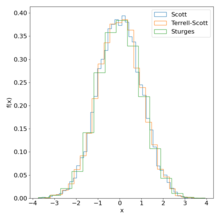Scott's rule is a method to select the number of bins in a histogram. Scott's rule is widely employed in data analysis software including R, Python and Microsoft Excel where it is the default bin selection method.
For a set of observations let be the histogram approximation of some function . The integrated mean squared error (IMSE) is
Where denotes the expectation across many independent draws of data points. By Taylor expanding to first order in , the bin width, Scott showed that the optimal width is
This formula is also the basis for the Freedman–Diaconis rule.
By taking a normal reference i.e. assuming that is a normal distribution, the equation for becomes
where is the standard deviation of the normal distribution and is estimated from the data. With this value of bin width Scott demonstrates that
showing how quickly the histogram approximation approaches the true distribution as the number of samples increases.
Terrell–Scott rule
Another approach developed by Terrell and Scott is based on the observation that, among all densities defined on a compact interval, say , with derivatives which are absolutely continuous, the density which minimises is
Using this with in the expression for gives an upper bound on the value of bin width which is
So, for functions satisfying the continuity conditions, at least
bins should be used.

This rule is also called the oversmoothed rule or the Rice rule, so called because both authors worked at Rice University. The Rice rule is often reported with the factor of 2 outside the cube root, , and may be considered a different rule. The key difference from Scott's rule is that this rule does not assume the data is normally distributed and the bin width only depends on the number of samples, not on any properties of the data.
In general is not an integer so is used where denotes the ceiling function.
References
- Scott, David W. (1979). "On optimal and data-based histograms". Biometrika. 66 (3): 605–610. doi:10.1093/biomet/66.3.605.
- "Hist function - RDocumentation".
- "Numpy.histogram_bin_edges — NumPy v2.1 Manual".
- "Excel:Create a histogram".
- Scott DW. Scott's rule. Wiley Interdisciplinary Reviews: Computational Statistics. 2010 Jul; 2(4):497–502.
- Terrell GR, Scott DW. Oversmoothed nonparametric density estimates. Journal of the American Statistical Association. 1985 Mar 1;80(389):209-14.
- ^ Scott, D.W. (2009). "Sturges' rule". WIREs Computational Statistics. 1 (3): 303–306. doi:10.1002/wics.35. S2CID 197483064.
- Online Statistics Education: A Multimedia Course of Study (http://onlinestatbook.com/). Project Leader: David M. Lane, Rice University (chapter 2 "Graphing Distributions", section "Histograms")
 observations
observations  let
let  be the histogram approximation of some function
be the histogram approximation of some function  . The integrated mean squared error (IMSE) is
. The integrated mean squared error (IMSE) is

 denotes the
denotes the  , the bin width, Scott showed that the optimal width is
, the bin width, Scott showed that the optimal width is

 becomes
becomes

 is the
is the 
 defined on a
defined on a  , with derivatives which are
, with derivatives which are  is
is

 in the expression for
in the expression for 

 , and may be considered a different rule. The key difference from Scott's rule is that this rule does not assume the data is normally distributed and the bin width only depends on the number of samples, not on any properties of the data.
, and may be considered a different rule. The key difference from Scott's rule is that this rule does not assume the data is normally distributed and the bin width only depends on the number of samples, not on any properties of the data.
 is not an integer so
is not an integer so  is used where
is used where  denotes the
denotes the